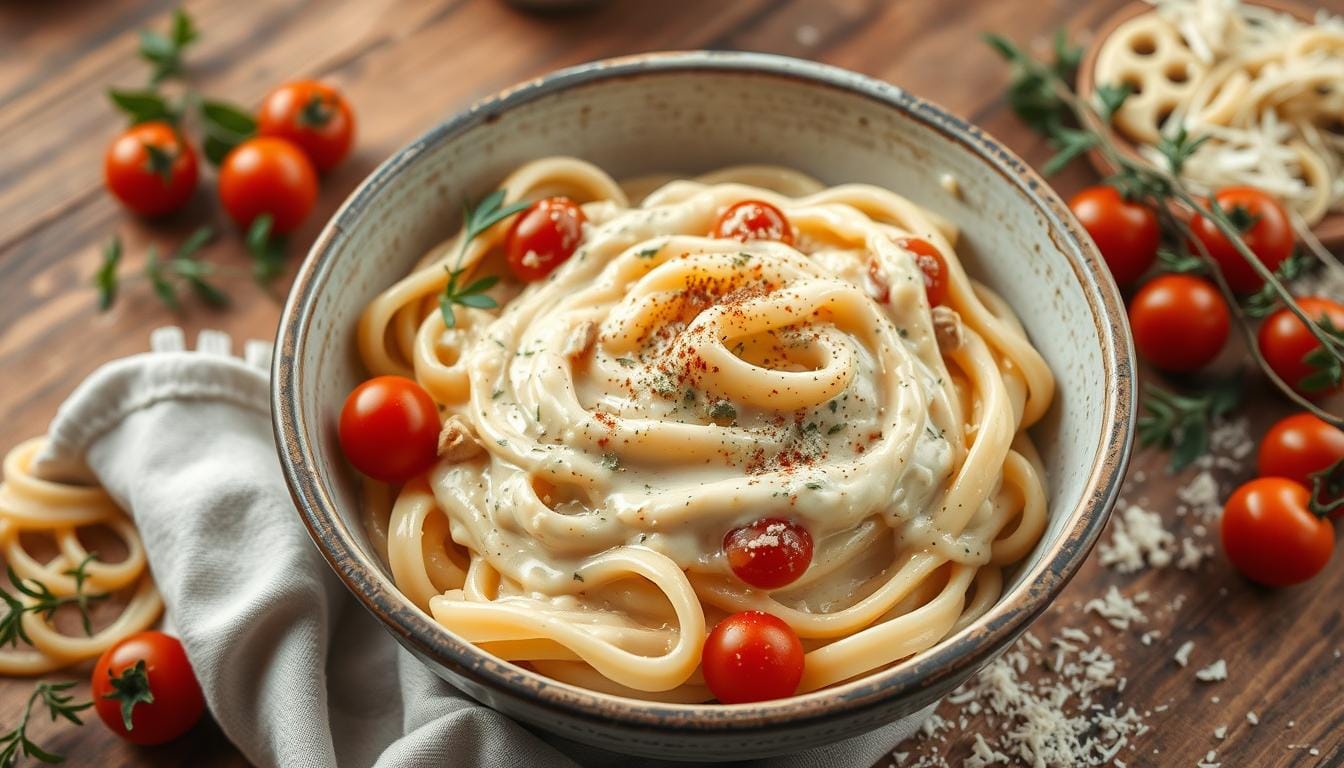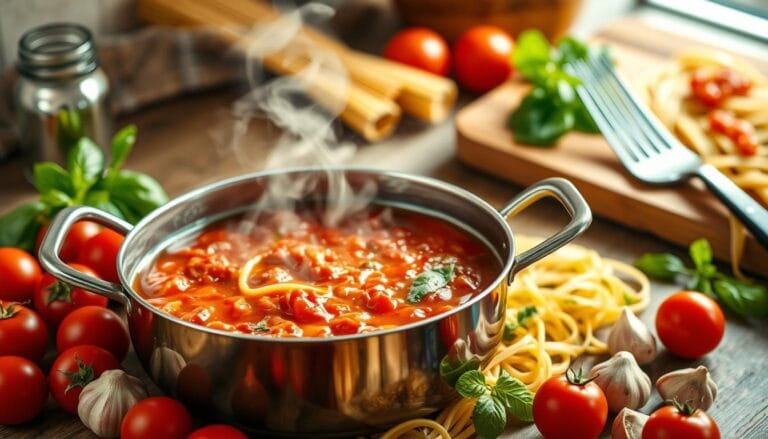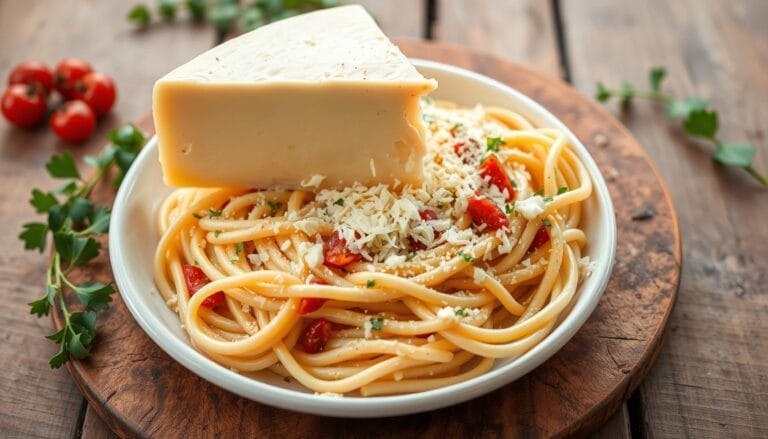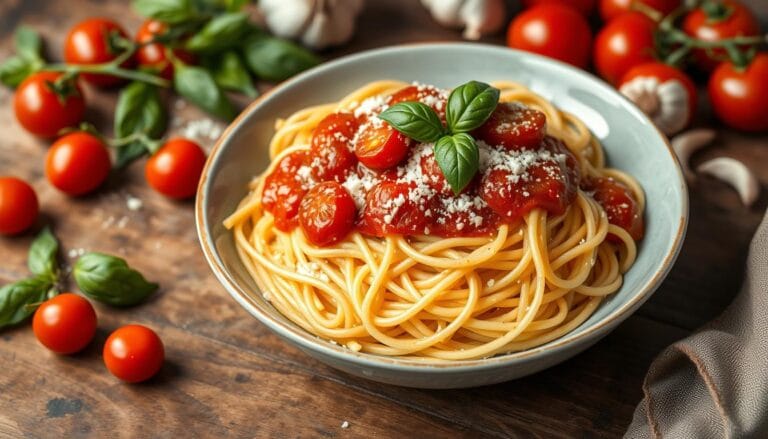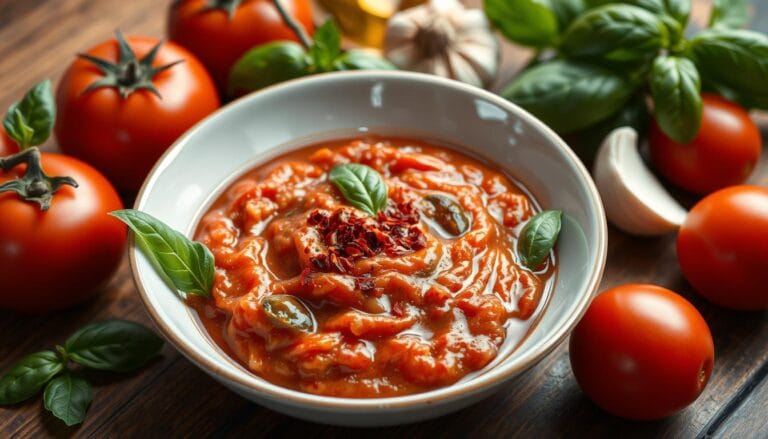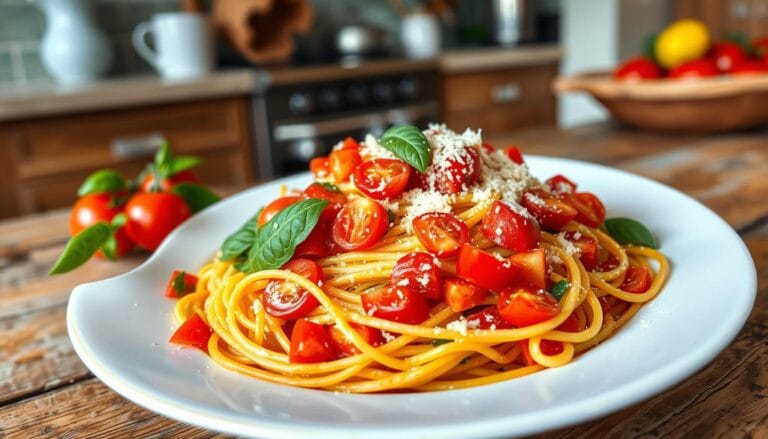How to make a creamy cottage cheese sauce for pasta.
Table of Contents
As a busy parent, finding healthy, homemade meals can be tough. But, what if I told you about a creamy pasta sauce made from cottage cheese? This dairy staple makes a sauce that’s both creamy and packed with protein. It’s a game-changer for your taste buds.
In this guide, you’ll learn how to make a creamy cottage cheese sauce. It’s perfect for making your pasta dishes better. It’s also a great choice if you want to add more protein and nutrients to your meals. This recipe is sure to be a hit with your family.
Benefits of Using Cottage Cheese in Pasta Sauce
Adding cottage cheese to your pasta sauce brings many health benefits. It’s packed with protein, offering up to 28 grams per cup. This makes it a great choice for a protein pasta sauce, helping your muscles grow and repair.
High Protein Content
Cottage cheese has almost 30 grams of protein per cup. This high protein content helps you feel full and satisfied. It’s a perfect choice for a healthy pasta sauce.
Lower Calorie Alternative
Cottage cheese is a lower calorie option compared to heavy cream-based sauces. It still gives your pasta dishes a rich and creamy texture. This makes it ideal for those who want a creamy cottage cheese sauce without extra calories.
Rich and Creamy Texture
When blended, cottage cheese creates a silky smooth texture. It’s perfect for a creamy pasta sauce. Its mild, slightly tangy flavor also complements pasta dishes well, making it a versatile ingredient.
Using cottage cheese in your pasta sauce offers a nutritious and tasty meal. It satisfies your taste buds and meets your body’s needs. Try adding this versatile ingredient to your cooking for a protein pasta sauce that will wow your guests.
Essential Ingredients for the Perfect Cottage Cheese Sauce
Making a creamy cottage cheese pasta sauce needs the right ingredients. Start with full-fat cottage cheese for a rich, protein-rich base. Add whole milk and Parmesan cheese to make it creamy.
Unsalted butter is key for a smooth sauce. Onion and garlic add flavor. Italian herbs like basil, oregano, and thyme give it a savory taste. Nutmeg and black pepper enhance the flavors.
For a thicker sauce, use a bit of cornstarch. It makes the sauce creamy and sticks well to pasta.
| Ingredient | Amount |
|---|---|
| Full-fat cottage cheese | 1 cup |
| Whole milk | 1/2 cup |
| Parmesan cheese, grated | 1/4 cup |
| Unsalted butter | 2 tablespoons |
| Yellow onion, finely chopped | 1/4 cup |
| Garlic, minced | 2 cloves |
| Italian seasoning blend | 1 teaspoon |
| Nutmeg | 1/4 teaspoon |
| Salt and freshly ground black pepper | To taste |
| Cornstarch (optional) | 1 teaspoon |
The secret to a great cottage cheese pasta sauce is using top-notch ingredients. Choose the best homemade pasta sauce for a memorable meal.
Kitchen Equipment You’ll Need
To make the perfect creamy cottage cheese sauce, you need some key tools. A high-speed blender or food processor is crucial for a smooth texture. You’ll also need a large pot for pasta and a colander for draining. A saucepan for heating the sauce and a silicone spatula or wooden spoon for stirring are also important.
Blender Requirements
For a silky smooth cottage cheese sauce, a powerful blender or food processor is essential. Choose one that can handle thick, creamy textures well. A high-speed blender like a Vitamix or Blendtec works best, blending the cottage cheese into a smooth, pourable sauce.
Cooking Utensils
- Large pot for cooking pasta
- Colander for draining cooked pasta
- Saucepan for heating the cottage cheese sauce
- Silicone spatula or wooden spoon for stirring
- Optional: Small sauté pan for cooking onions and garlic
Pots and Pans
You’ll also need basic pots and pans for the dish. A large pot is key for boiling pasta, and a colander is needed for draining. A saucepan is best for warming the cottage cheese sauce. If you’re sautéing onions or garlic, a small sauté pan is handy.
“Having the right kitchen tools on hand makes all the difference when crafting a delicious cottage cheese pasta sauce.”
Selecting the Right Type of Cottage Cheese
Choosing the right cottage cheese is key to a creamy pasta sauce. The best cottage cheese for pasta sauce is full-fat. It gives a richer, creamier texture that stays smooth when heated.
Good Culture is known for its high-protein cottage cheese. It makes a smooth, velvety sauce. Stay away from low-fat or non-fat cottage cheese. They can make the sauce less creamy and separate when heated.
The texture of cottage cheese isn’t as important. The sauce will be blended until it’s silky-smooth. But, smaller-curd cottage cheese blends better and is more uniform.
“The key to a creamy cottage cheese sauce is using the full-fat version. It provides a luxurious mouthfeel that can’t be replicated with lower-fat varieties.”
When picking your full-fat cottage cheese, look for high protein and a clean taste. This makes your pasta sauce tasty and nutritious.
Basic Steps for Making Cottage Cheese Sauce
Making a creamy cottage cheese sauce for pasta is simple. Just follow a few easy steps to make your pasta meals better. Let’s explore how to make this tasty sauce.
Blending Technique
To get a smooth cottage cheese sauce, blending is key. Put cottage cheese, milk, and seasonings in a blender. Blend until it’s smooth and lump-free. This makes the sauce creamy and velvety.
Heating Process
After blending, move the mix to a saucepan. Heat it over low-to-medium heat. Stir often to mix flavors and thicken the sauce. Don’t let it boil to avoid curdling.
Temperature Control Tips
- Keep the heat low to prevent curdling.
- Stir constantly to avoid sticking and uneven heating.
- If it gets too thick, add a bit of pasta water to thin it out.
By following these steps, you’ll make a creamy cottage cheese sauce. It will enhance your pasta dishes. Enjoy your homemade sauce!
Seasoning and Flavor Enhancements
Boosting the taste of your cottage cheese pasta sauce is simple and fun. Begin by adding garlic powder, onion powder, and a mix of Italian herbs. A bit of black pepper and a pinch of nutmeg can make the sauce richer and more complex.
Adding chopped fresh basil or oregano can bring a fresh taste. Cooking onions and garlic before mixing them in can make the sauce taste deep and sweet. Be careful with the salt since cottage cheese and Parmesan are already salty.
Try out different spice mixes to find the flavor you love. The great thing about cottage cheese sauce is you can change the seasonings to your heart’s content.
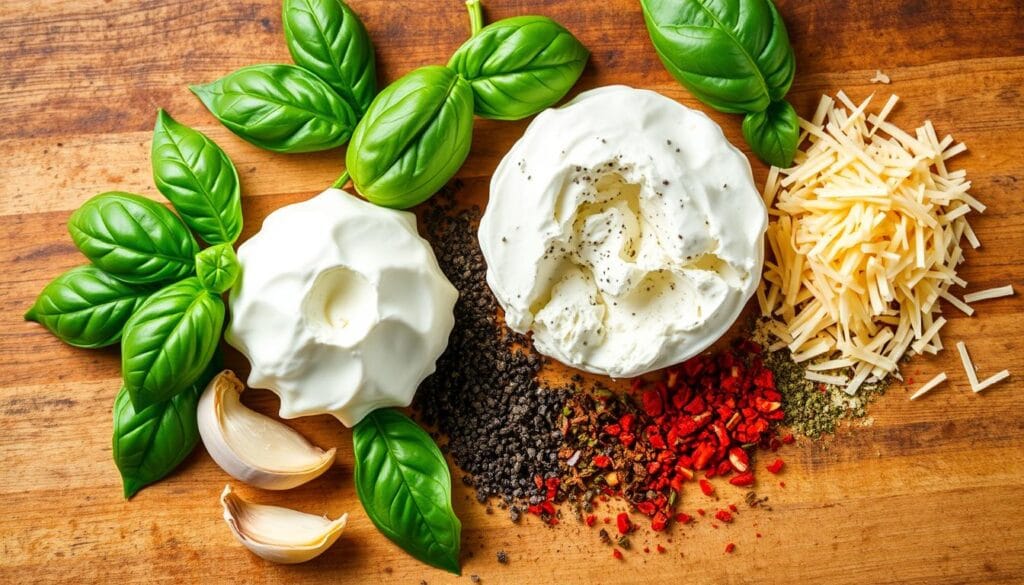
“The right blend of seasonings can transform a simple cottage cheese sauce into a culinary masterpiece.”
Common Mistakes to Avoid
Making the perfect creamy cottage cheese sauce for pasta is fun. But, you must avoid common mistakes. These can ruin your sauce. By knowing a few key tips, you can make your sauce silky-smooth and full of flavor.
Temperature Issues
Temperature control is key for a creamy sauce. Don’t add the sauce to very hot pasta. This can make the cottage cheese curdle. Let the pasta cool a bit before adding the sauce.
Also, don’t overheat the sauce. Simmer it gently instead of boiling. High heat can make the sauce grainy or separate.
Texture Problems
A smooth, lump-free texture is essential for a creamy sauce. Make sure to blend the cottage cheese well. This will help you avoid any lumps in your sauce.
Seasoning Errors
Be careful when seasoning your sauce. Cottage cheese and Parmesan can be salty. Start with a little salt and taste as you go. This way, you won’t over-season.
Also, use garlic powder instead of fresh garlic. Fresh garlic can overpower the sauce’s flavors.
Remember these cottage cheese sauce tips and troubleshooting pasta sauce tricks. They will help you make a creamy, delicious sauce. Your pasta dishes will be even better.
Best Pasta Types for Cottage Cheese Sauce
Choosing the right pasta for a creamy cottage cheese sauce is key. Penne, rigatoni, and fusilli are great picks. Their shapes let the sauce coat every part of the pasta. Cavatappi and rotini also pair well, offering a perfect match.
Adding chickpea pasta boosts the dish’s protein. Its nutty taste and firm texture go well with the sauce. You can use about half a pound of pasta, but adjust as you like.
| Pasta Type | Texture | Protein Content |
|---|---|---|
| Penne | Ridged, tube-shaped | 6g per serving |
| Rigatoni | Ridged, tube-shaped | 6g per serving |
| Fusilli | Spiral, corkscrew-shaped | 7g per serving |
| Cavatappi | Spiral, corkscrew-shaped | 6g per serving |
| Rotini | Spiral, corkscrew-shaped | 7g per serving |
| Chickpea Pasta | Firm, nutty flavor | 25g per serving |
Look for pasta that holds the sauce well. This ensures every bite is full of flavor and texture. Try different shapes to find your favorites.
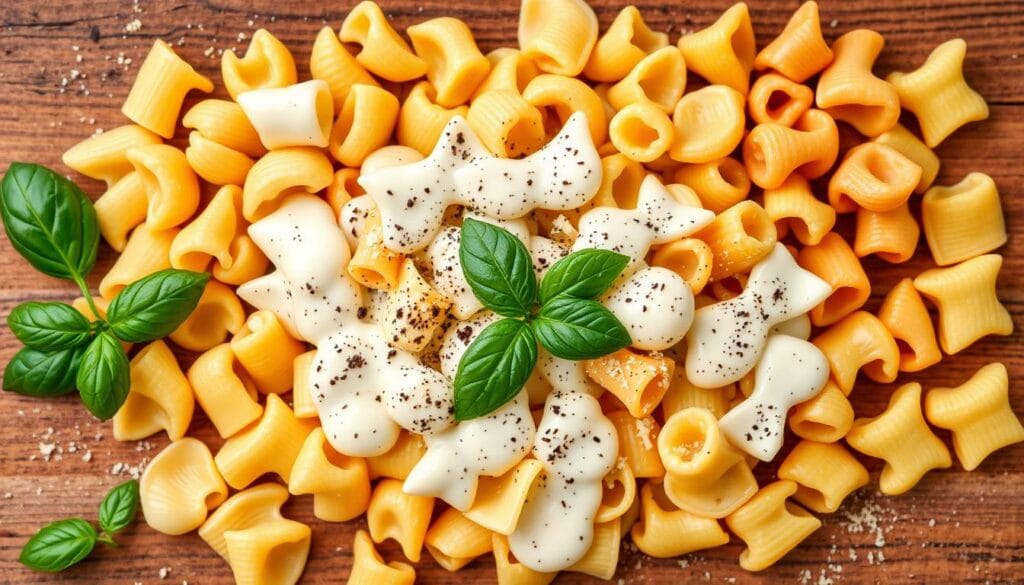
Making the Sauce Creamy and Smooth
To get the perfect smooth cottage cheese sauce or creamy pasta sauce technique, blending is key. Use a high-speed blender or food processor. This ensures the cottage cheese mixture is velvety and lump-free.
Blend the cottage cheese, milk, and other ingredients until smooth. Make sure there are no curds or lumps left. Blend on high speed for a minute or two, stopping to scrape the sides as needed.
Some recipes suggest adding a thickening agent like cornstarch or arrowroot powder. Whisk a small amount into the sauce and heat it gently until it thickens.
When heating the smooth cottage cheese sauce or creamy pasta sauce, avoid overheating. Gentle, consistent heat prevents separation or curdling. Stir often and watch the temperature to keep it velvety.
With proper blending and heating, cottage cheese becomes a smooth cottage cheese sauce or creamy pasta sauce. It’s great for tossing with pasta dishes.
Variations and Add-ins
The beauty of a cottage cheese pasta sauce is its versatility. Adding a few simple ingredients can boost flavor and nutrition. Try fresh herbs, aromatic veggies, and protein-rich foods for a personalized pasta dish.
Herbs and Spices Options
- Fresh basil adds a bright, herbal note to the sauce.
- Dried oregano or thyme lend an earthy, Mediterranean flair.
- A sprinkle of crushed red pepper flakes can add a subtle heat.
- Minced garlic and onion enhance the overall savory profile.
- For a Cajun twist, try a dash of Cajun seasoning.
Vegetable Additions
- Sautéed spinach or kale provide a nutrient-dense boost.
- Diced tomatoes or a touch of marinara sauce can create a creamy tomato-based sauce.
- Roasted broccoli or peas add color and crunch.
- Sautéed mushrooms lend an earthy, umami flavor.
- Caramelized onions and bell peppers add sweetness and depth.
Protein Combinations
For a heartier meal, consider adding your favorite protein:
- Grilled or sautéed chicken breast for a classic pairing.
- Sautéed shrimp or scallops for a seafood twist.
- Crumbled tofu or tempeh for a plant-based option.
- Cooked Italian sausage or ground turkey for a protein-packed sauce.
Customizing your cottage cheese pasta sauce is endless. By adding herbs, veggies, and proteins, you can make a dish that’s uniquely yours. It’s a great way to enjoy a flavorful meal that suits your taste.

Storage and Reheating Guidelines
Enjoying creamy pasta with cottage cheese sauce doesn’t have to end after one meal. You can enjoy leftovers for days with the right storage and reheating. Here’s how to make storing cottage cheese pasta and reheating creamy pasta easy:
Storing Leftover Cottage Cheese Pasta
For leftover cottage cheese pasta, move it to an airtight container. Then, refrigerate it for up to 4 days. This keeps the sauce fresh and creamy, preventing it from drying out or separating.
Reheating Cottage Cheese Pasta
To reheat creamy pasta, avoid overheating. Overheating can ruin the sauce. Instead, gently warm it in the microwave, stirring every 30 seconds. Or, reheat it on the stovetop over low heat, stirring often.
If the sauce is too thick after refrigeration, add a bit of milk or pasta water. This will make it smooth and creamy again.
| Storage Method | Recommended Time | Reheating Technique |
|---|---|---|
| Refrigerator in Airtight Container | Up to 4 days | Microwave in 30-second increments or Stovetop over low heat |
By following these simple storage and reheating guidelines, you can enjoy your cottage cheese pasta for longer. Enjoy your leftovers to the fullest!
Nutritional Benefits and Values
This creamy cottage cheese pasta sauce is packed with nutrients. Cottage cheese is a top source of protein. A half-cup has about 116 calories, 14 grams of protein, and only 3 grams of saturated fat.
It’s a better choice than traditional cream-based sauces because it’s lower in calories. A serving size of 1/4 of the recipe has 120-337 calories, 9-28 grams of protein, and 6-11 grams of fat.
Cottage cheese also offers other important nutrients. A half-cup gives you 14% of your daily phosphorus, nearly a third of your vitamin B12, and about 8% of your calcium. It’s great for your health and well-being.
Some cottage cheese brands may have added sugars or more sodium. Always check the labels. Choose low-sodium or unsweetened options for the best nutrition.
| Nutrient | Cottage Cheese (1/2 cup) | Low-Fat Greek Yogurt (1/2 cup) |
|---|---|---|
| Calories | 116 | 100 |
| Protein | 14g | 17g |
| Saturated Fat | 3g | 0.5g |
| Calcium | 138mg | 154mg |
| Sodium | 452mg | 53mg |
Adding this cottage cheese pasta sauce to your meals is a smart choice. It’s nutritious and supports your health goals. Its cottage cheese pasta nutrition makes it a top pick for a healthy pasta sauce.
Serving Suggestions and Pairings
Make your cottage cheese pasta dish even better by adding sides and toppings. Serve it with a fresh salad for a complete meal. The salad’s cool greens and juicy tomatoes contrast nicely with the creamy sauce. Roasted veggies like asparagus or beets add color and nutrition.
For more protein, try grilled chicken or fish. These options keep you full and energized. Add some fresh herbs, Parmesan cheese, or black pepper for extra flavor.
For a richer pasta experience, try it with garlic bread or breadsticks. The buttery, garlicky taste goes well with the creamy pasta. It’s a comforting meal that everyone will love.
Suggested Pairings and Toppings
- Fresh salad greens
- Roasted vegetables (asparagus, green beans, beets)
- Grilled chicken or baked fish
- Freshly chopped herbs
- Grated Parmesan cheese
- Garlic bread or breadsticks
| Pairing | Benefits |
|---|---|
| Salad | Provides a refreshing contrast to the creamy pasta, adding fiber and vitamins. |
| Roasted Vegetables | Adds a pop of color, texture, and extra nutrients to the meal. |
| Protein (chicken, fish) | Boosts the protein content for a more balanced and satisfying dish. |
| Herbs and Cheese | Enhances the flavor profile and adds a touch of elegance to the final presentation. |
| Garlic Bread | Provides a comforting, indulgent accompaniment to the creamy cottage cheese pasta. |
Adding these tasty pairings turns your cottage cheese pasta into a full and satisfying meal. Try different flavors and textures to find your favorite combination.
Conclusion
Making a creamy cottage cheese pasta sauce is a fun way to make your pasta dishes healthier. This sauce is both tasty and nutritious, making it a great choice instead of heavy cream sauces. It adds creaminess and protein to your pasta, making it satisfying and good for you.
Whether you want a classic alfredo or something new, cottage cheese sauce is perfect. It’s high in protein and low in fat, great for a balanced diet. You can still enjoy a creamy pasta dish without feeling guilty.
Exploring creamy cottage cheese pasta recipes and healthy alfredo alternatives is exciting. The secret to success is choosing the right cottage cheese and learning how to blend and heat it. Don’t forget to try different seasonings and add-ins to find your favorite flavors. With a bit of practice, you’ll make delicious, healthy cottage cheese pasta sauces that taste amazing and are good for you.
FAQ
What are the key ingredients needed to make creamy cottage cheese pasta sauce?
To make creamy cottage cheese pasta sauce, you need full-fat cottage cheese, milk, and Parmesan cheese. Also, butter, onion, garlic, salt, and pepper are key. You can add Italian herbs, garlic powder, onion powder, and nutmeg for extra flavor.
What type of cottage cheese is best for making this sauce?
Use full-fat cottage cheese for the creamiest sauce. Good Culture is a good choice because of its high protein. Low-fat cottage cheese won’t give you the same creamy texture.
What kitchen equipment is needed to make the perfect cottage cheese sauce?
You’ll need a high-speed blender or food processor for a smooth sauce. A large pot, colander, and saucepan are also necessary. A silicone spatula or wooden spoon helps with stirring.
How do you blend the cottage cheese to get a smooth, creamy texture?
Blend cottage cheese, milk, and seasonings until smooth. Saute onions and garlic first for extra flavor. Don’t overheat the sauce to avoid curdling.
What are some common mistakes to avoid when making cottage cheese pasta sauce?
Don’t add the sauce to very hot pasta to prevent curdling. Simmer the sauce gently instead of boiling. Make sure to blend well to avoid lumps. Be careful with salt since cottage cheese and Parmesan are salty. Avoid using fresh garlic as it can be too strong.
What are some variations and add-ins for cottage cheese pasta sauce?
Try adding herbs like basil, oregano, or thyme. You can also add vegetables like spinach, broccoli, or peas. For protein, add grilled chicken, shrimp, or tofu. For a Cajun twist, add Cajun seasoning. For a creamy tomato sauce, blend in marinara sauce.
How should you store and reheat leftover cottage cheese pasta sauce?
Store leftover pasta with cottage cheese sauce in an airtight container in the fridge for up to 4 days. Reheat gently to prevent separation. Use the microwave in 30-second increments or reheat on the stovetop over low heat.
What are the nutritional benefits of using cottage cheese in pasta sauce?
This sauce is high in protein thanks to cottage cheese. It’s also lower in calories and fat than traditional cream-based sauces. A serving has about 120-337 calories, 9-28g protein, and 6-11g fat, depending on the recipe.

